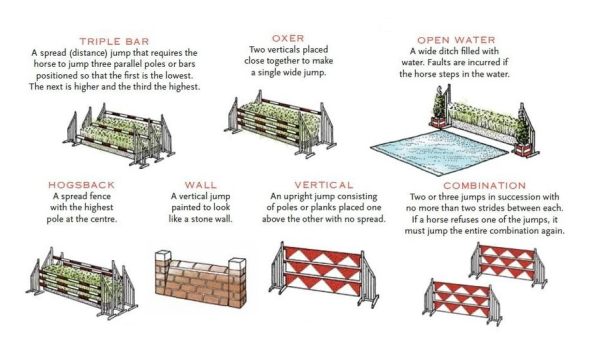Types Of Horse Jumps

Watch an equestrian event, and the odds are good that at some point you’ll witness riders in English saddles taking their mounts over a variety of horse jumps. Whether you’re simply curious or are perhaps interested in learning to jump, you’ll find this guide to the most popular types of horse jumps is a good place to begin.
Triple Bar
Triple bar jumps are quite challenging, in terms of both height and width. These jumps consist of a spread fence with three jumps at different heights, usually ascending.
Oxer
An Oxer is a fairly advanced jump, particularly if it’s high. This configuration calls for a pair of verticals placed near one another, widening the jump.
Open Water
An open water jump is basically a wide gulley of water, either with or without additional features. Sometimes set up in combination with a bounce or a wall, this can be among the most spectacular of horse jumps to see.
Hogsback
The hogsback or hogs back is one of the horse jumps commonly seen in more advanced events. This configuration features uneven poles, usually a set of three. Each of the poles is at a different height, with the highest one occupying the middle position.
Wall
As its name suggests, a wall is a jump that looks like a decorative wall. These horse jumps are made to resemble stone or brick, but are made up of lightweight material that will fall over easily in case of an accident.
Vertical
Vertical horse jumps are obstacles that consist of poles placed vertically one on top of another, with no spread or space between bars.
Combination
A combination is simply a series of horse jumps set up in a row of two or three. The difference between a simple combination and a bounce is that there’s room for the horse to take some strides between jumps.
Bank
Banks are jumps that go from one level to another. A bank can be approached from the uphill or downhill side. The uphill approach is safer and easier for the horse to navigate.
Bounce
Bounces are horse jumps consisting of multiple fences with no room for the horse to take a stride between jumps. A bounce can consist of just two jumps setup in close proximity to one another, or it can be made up of several fences. The more fences in the bounce, the more challenging it is for horse and rider to navigate.
Brush Fence
A brush fence, like the ones commonly seen on steeplechase courses, consists of a bottom wall topped with a layer of brush. Brush fences can be challenging, and it’s not uncommon for a horse in training to express some fear about crossing.
Cross Rail
As the name suggests, a cross rail is an x-shaped jump. To form a simple cross rail, two jump poles are supported at either end, providing a low space at the center that’s easier for short or uninitiated horses to get over. If you are new to jumping, a cross rail is one of the first types of horse jumps you’ll be going over.
Liverpool
Remember the word “pool” and you’ll never forget what a Liverpool horse jump is. This obstacle features a pool of water beneath an oxer or vertical, widening the jump and adding visual interest to a jump course.
Comments : 0